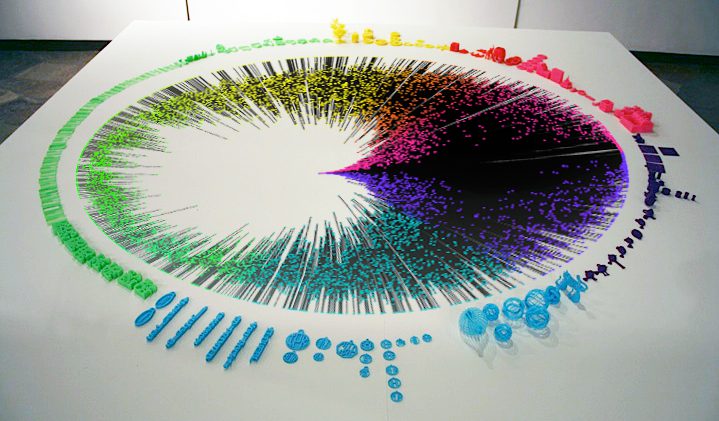Who Would Have Thought Elephants?
The title of this exhibition, “Actuals Create New Adjacent Possibles”, comes from the writing, Prolegomenon to a General Biology, by Stuart Kauffman. The audio below is an interview between the artist Allison Kudla and Stuart Kauffman.
He theorizes that there are no entailing laws for the biosphere. We cannot pre-state all possible outcomes; we can only say that an actual creates a new adjacent possible. This theory is useful not only in thinking about biological evolution, but also in the discussion of cultural evolution and the seemingly unpredictable nature of innovation.
In the audio recording below, he traces a fairly rapid vector for telecommunications and personal computers. Though the dots he is connecting are plausible, they aren’t necessarily backed by scientific evidence. Kudla set out to tell a story of cultural evolution of a particular dataset, the Thingiverse, but in her framework, she implements similar methods data scientists use when sorting genome sequences.
Even if we agree there are no entailing laws of the biosphere, scientists and mathematicians continue to invent algorithms and computational tools for organizing and structuring biological data. These structures and frameworks can then be used to tell the history of evolution. Though we cannot predict, imagine if we are able to cut the lag time, and begin to tell the stories of the biosphere as they are unfolding? What impact could this have on cultural evolution?
Listen to the 10 minute interview with Stuart Kauffman, discussing the concepts described above.
Sorting the Thingiverse

Thingiverse is an online digital community for the 3D printer, Makerbot. Started in about 2008, as of 2015 it has just over 600,000 objects that can be shared and downloaded by any person on the Internet. Each object is numbered; the first thing was number 1, the most current thing, just over 600,000.
In this project, a 5% data sample of the Thingiverse was taken, focusing only on the object number and its attributes, i.e.: the words being used to describe it. The data was then organized using a unique parsimony method.
This project was made possible by the work of Max Robinson, a data scientist at the Institute for Systems Biology. The Thingiverse data is sorted based on a set of algorithms he created, which he calls the Espalier technique. This technique was designed as a form of molecular phylogenetics (determining the tree of relationships among individuals using “attributes” of their genomes — similarities and differences in their DNA). Phylogenetics is daunting due to the vast number of potential trees; the Espalier technique attempts to reduce this complexity by ordering the individuals along a line or circle, then considering only the trees that can be drawn without crossed branches. In this project, we re-purposed the algorithm to sort Thingiverse objects by their attributes.
Espalier comes from the French horticultural technique that organizes the branches and fruit of trees on a fence, wall, or lattice. In his work, it is an analogy to “laying flat” a complex data set to expose its internal structure.
“Actuals Create New Adjacent Possibles” was created for the ArtSySTEM program at USU, Logan. Curated by Mark Lee Koven.
